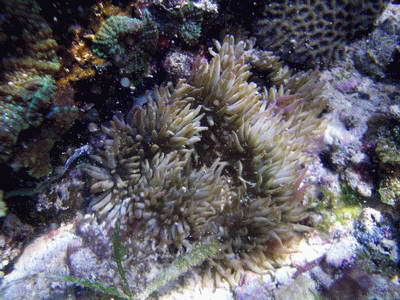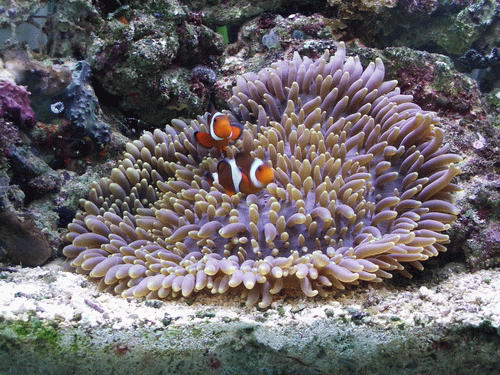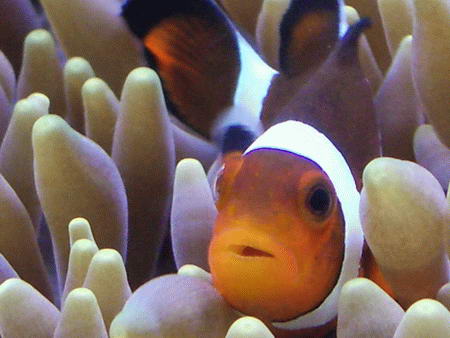I do not recommend an anemone for newly established tanks
or the
inexperienced reef keeper either. The stress of being shipped and moved
between numerous holding tanks puts a great strain on these creatures
and not all will do well or survive even with our best attempts. As
with purchasing fish, I would want to know that the anemone has been at
the local fish store for at least a few weeks to ensure it had at least
survived the journey somewhat intact. Newly established aquariums also
pose a threat to anemone as the biology of the tank in such a new setup
is usually never firmly established or balanced yet. Which can cause
water quality issues that will quickly effect the anemone.
Take great care in the selection of your new anemone also, study the
various species, of which I will try to provide links to, and do your
best to pick the healthiest looking one in the holding tank. What you
want to look for is good coloration as per the species type, If you see
one that looks as if it has been bleached white, pass that one up.
Anemone host and depend upon symbiotic algae just as corals do. If
they have lost their symbiots then it is just a matter of time before
its demise. It should also have full,firm tentacles extended. One that
is all shriveled up and remains so, is not a good choice. Also keep in
mind that with all species, there are types that are more delicate than
others. This is where studying comes in handy.
A Note about White Anemones
: Far to often I see photos of recently purchased anemones that
are white. While a white anemone may appear beautiful, it is however,
a very bad sign that the anemone has bleached. Keep in mind that
anemone, just like most corals, have zooxanthellae within their
tissues, hence the need for intensive lighting just as you would
provide for most corals. Being white simply indicates that the anemone
has expelled or lost its symbiotic zooxanthellae, which without, the
anemone can slowly decline and die. While there are some naturally
occurring white anemones, they are of the species that we would not see
for sale at a fish store. The commonly offered species, such as the
sebae and carpet types should have some coloration to them, usually a
golden brown, as shown in the below photo.
If you
have recently purchased a bleached anemone, all is not lost as the
anemone might be able to regain its zooxanthellae and recover. During
its recovery, it is important that you feed the anemone a bit more
often than usual as it does not have the zooxanthellae to provide for
its needs. When feeding such an anemone, do so with very small pieces
of seafood, such as shelled, uncooked shrimp or any type of fresh meaty
seafood. Hopefully in a matter of a month or two, the anemone
will begin to regain itself and return to its former glory.
Feeding an Anemone
- Since this seems to be a subject most often asked about,
I will try to give it some clarity. Which as with every subject
within this hobby it is one of what you want to accomplish and how the
anemone is kept. Which I feel can be broken down into two categories.
An Anemone with no clownfish
- Since I believe that clownfish, by their just hosting an
anemone will provide for all of its food by either swimming out and
bringing food back to the anemone or by defecating upon the anemone,
which with the amount of time a clownfish hovers above an anemone, this
alone is probably the largest source of nutrients for the anemone. A
recent study done on wild anemone backs this up by showing that anemone
in the wild that do not have clownfish hosting them will not survive
long as well as not growing at the rates that other anemone do that
have clownfish. As such, if your anemone does not host a clownfish,
then you should target feed the anemone once a week with any seafood
meat such as shrimp or fish meat. Each piece should be no larger than
1/4th inch cubed. Any larger, and the anemone may spit out the
remainder as it is unable to digest large pieces quick enough before
the food begins to spoil within the anemone.
An Anemone with a clownfish
- As noted above, as long as there is a clownfish hosting an anemone,
it has no need to be target fed by you. It will do just fine with what
the clownfish provides for it. Why add more nutrients (food) to your
system if its not actually required.
Propagating Anemone
- While anecdotal, it may still be a valid observation that if
you want your anemone to split or reproduce, frequent water changes
along with target feeding the anemone every 3 to 4 days seems to induce
the anemone to split (clone). This makes sense to me since for any
animal to have the energy to reproduce, it must have the protein
available. I also believe that the better water quality and the
abundant food cues the anemone that it is in a very suitable
environment capable of supporting more anemone like itself, a kind of
trigger if you will.


An Illustrated Glossary of Sea Anemone Anatomy( Please take the time to fully explore this site )
Sea Anemone Identification , biology and distribution - The best resource I have found for anemone, a must see site!
Introduction to Sea Anemone Anatomy - " Although sea anemones are among the simplest of animals, they possess one of the
most complex structures in the animal kingdom: the nematocyst, or stinging capsule. Their
possession of this feature places sea anemones in the phylum known as Cnidaria,
in which jellyfish, corals, and hydra are also found. "
Glossary of Sea Anemone Terms - " This page contains a list of terms and definitions relevant to sea anemones and
their anatomy. "
Sea Anemone Anatomy - Nematocysts - " Contains images of sea anemone nematocysts, which are the stinging capsules
characteristic of the phylum Cnidaria. "

The primary causes of sea anemone mortality or health issues within the hobby are probably the lack of
:
1) proper feeding,
2) lack of proper physical conditions, temperature, salinity, pH, water flow rates and overall water quality.
3) placement in tanks with animals that can
chemically kill them.
Any "mushroom" polyps, soft corals, or
sponges are the prime sources of potential problems. The chemicals they release (allelopathy) may work
over very short distances and be "localized" in their responses as not all
animals of a given species will have similar responses to similar poisons. What may effect one species may not bother another.
Sea Anemone Profiles - " Species profiles and care tips. "
Be a host to your Anemone - " Great overall article on their care and selection "
Keeping Anemones - "
Part of the problem is that these anemones are not really "reef" animals in the
typical sense of the phrase, and part is that husbandry of anemones is poorly
understood. "

Ceranthids (tube anemone) - Not considered a true anemone, and are not the fish killers that hobby lore makes them out to be.
Entacmaea quadricolor (bulb tipped anemone)
- One of the most popular species kept, further evidence suggests that
the appearance of its "bulbs" relies upon having a clownfish hosting
the anemone and not so much on the available light intensity.
Heteractis crispa (sebae anemone) - One of the most commonly
available species, yet seems to be a troublesome anemone to keep.
Heteractis magnifica (Ritteri anemone) - Another splendid looking
anemone which clownfish will host. Requires stronger light intensity
than most other species.
Macrodactyla doreensis (Long tentacled anemone) - Will burrow into sandbeds and can get to be a large specimen.
Condylactis sp. ( Condy anemone) - An Atlantic (Caribbean) species.
Stichodactyla sp. (Carpet anemone) - Can easily become a very
large animal and is quite capable of capturing fish within an enclosed
space. Some species can inflict a very painful sting upon humans as
well.
To be continued as I find relevant information

Within the last two years or so, I have seen at least 6 different types
of anemone and their various color morphs, which I believe just depends
as it does with corals, on their normal depth range which determines
the intensity of light they or more specifically, their zooxanthellae
(symbiotic algae) receive, as with corals, the greens and browns
(including tans) are always found in very shallow water, hence very
intensive light, while the reds and blues tend to be far deeper.
I have never seen any type of anemone that was not on/in a rock or
coral head, and never on top of the rocks, always on a side which they
then extend a bit to be able to spread out on an average of about 45
degrees from horizontal, a large majority of them also will be right on
the sand but always in a crevice or a small sand bottomed cave within
the side of a rock. Carpet anemone tend to not extend their foot as
deeply as other species I have collected. It also seems that all types
prefer their "hole" to be of a size that they can swell and fill it
completely, maybe this is their way of sealing their hole from unwanted
intruders and may explain why most anemone seem to move about a lot
within our tanks, they may just be looking for the right "fit". For my
anemone I always create a specific hole for them,usually at a slight
angle, and just slightly larger than about two inches from the top of
their base, not from their foot. This almost always works, and have
noted that if when first placed and you can catch them in the act of
moving and put them right back where they started from, they will
usually always plant themselves then.

A typical location for anemone, between the vertical wall of a rock and the bottom substrate
I have seen a lot of recommendations on the feeding of anemone, I for
one have never seen an anemone in the wild capture anything to eat, not
even a small fish. In fact, most types of anemone have a hard time to
hang onto a wiggling fish, If you have ever tried feeding a small live
fish to an anemone, you will see what I mean, unless you shove the fish
down deeply to allow the maximum number of tentacles to get a hold of
it, the fish will wiggle free. Plus the fact I have never seen a wild
born fish that did not know to steer clear of an anemone at all times,
although it has been observed now in Indonesia that hawk fish, cardinal
fish and other types have now learned to host with anemone just as the
clownfish and domino damsels do. I also have never seen domino
damsels in the wild that were not hosting an anemone, in fact, there
are more domino hosted anemone than there are clown hosted ones. I
firmly believe that while an anemone is very capable of consuming large
meaty items, they very rarely get that chance in the wild, of the few
species that I maintain in my reef tank, I never target feed any of
them, if they have a clown host, the only time they eat "meat" is if
the clowns swims out and grabs a piece and dutifully "feeds" it to the
anemone, the anemone without a clown do not get fed and still grow at
fast rates for me. Which begs the question, is it really necessary to
feed an anemone three times a week?
One other obvious observation from my experience with managing a LFS
and from what I see posted within the forum is that anemone do not
travel well, taking an educated guess, I would say that 2 out of three
anemone do not survive their first year in captivity, most, their first
month. Which is a shame for a creature that is capable of living beyond
one hundred years. Any species of anemone that I collect from the wild
has always done extremely well for me. The only thing that I can think
of at this time which would cause an anemone to not being able to
handle long distance transportation is the rough treatment they get,
after all they are really just bags of water, and am sure being bounced
around roughly does their internal organs harm, that and enduring weeks
of being kept basically in less than ideal conditions. Then after moving from one tank to
another during their journey, they then get tossed under intensive
lighting and yet another set of water parameters. Which is why water
and lighting acclimation is very important if they are to have any
chance at all.
Identification and Control of Aiptasia
Eric Borneman's Aiptasia control recipe:
100ml distilled water, 1 teaspoon Red Devil
lye (sodium hydroxide), and 2 teaspoons calcium hydroxide (kalkwasser). Mix well
and use a PD-Tip or dispensing syringe. Turn off water flow and let sit for one
hour before turning flow back on.
Note: This mixture is also effective in killing just about anything you
put it on, including out of control xenia, polyps and even some hair
algae types.
Please take a moment and consider supporting any one of the projects listed within. Thank you.









